Lenses having a focal length or focal length range wider than 35mm on a full frame camera can be considered wide-angle lenses, while lenses featuring focal lengths wider than 24mm can further be categorized into a subset known as “ultra-wide angle” lenses. The wide-angle lens has its unique features, I recommend checking the post “Canon Wide Angle Lens Review”
Recommended wide-angle lenses for Canon
If you shoot using a Canon or Nikon camera, then the best quality lenses are those made by the same manufacturer. However, these tend to be the most expensive, so if you are on a budget you should also consider the excellent alternatives made by other reputable companies like Tokina, Sigma, and Tamron.
1st wide angle lenses for Canon APS-C Cropped sensor camera
Sigma 8-16mm f/4.5-5.6 DC HSM for Canon
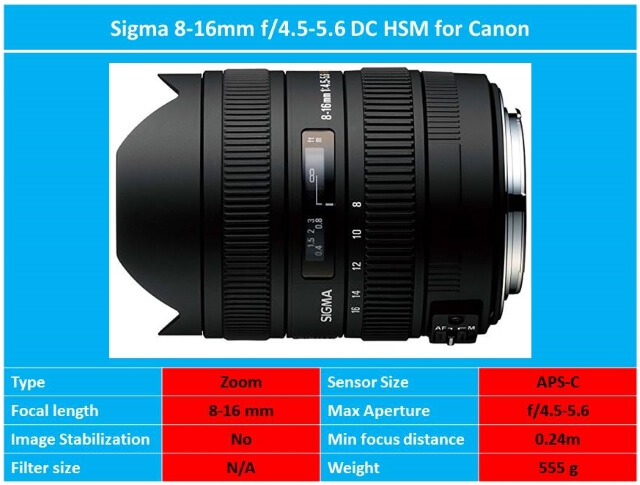
The Sigma 8-16mm F4.5-5.6 DC HSM is an ultra-wide zoom that has a 35mm equivalent angle of view of a 12-24mm lens when used on DSLRs with APS-C size image sensors. Sigma’s FLD glass elements, equal to fluorite glass, are correct for distortions and color aberrations to deliver beautiful high-contrast images.
The lens has a minimum focusing distance of 9.4″ (24cm) allowing you to get in close to a subject to create exaggerated perspectives. This super wide-angle zoom is perfect for shooting landscape photography, architecture, building interiors, photojournalism, wedding photography, group pictures and a wide variety of other shooting opportunities you may encounter.
The below is a sample photo by HAMACHI!

Sigma 10-20mm f/3.5 EX DC HSM for Canon

the Sigma 10-20mm f/3.5 EX DC HSM Autofocus Zoom is a super-wide-angle lens with a maximum aperture of f/3.5 throughout the entire zoom range, ensuring high image quality. The maximum aperture of f/3.5 allows enough light in to make it a great choice for indoor shooting as well as landscapes and creative portraiture.
With its wide-angle view from 102.4 degrees, this lens can empower the photographer to produce creative images with exaggerated perspective. This lens has a Super Multi-Layer coating that coating reduces flare and ghosting. With an HSM (Hyper-Sonic Motor), the lens operates quietly and at high speed in both autofocus and full-time manual modes.
The lens design incorporates an inner focusing system that eliminates front lens rotation, making the lens particularly suitable for using the Petal-type hood, reducing extraneous light, and reducing internal reflection.
Two ELD (Extraordinary Low Dispersion) glass elements and an SLD (Special Low Dispersion) glass element provide excellent correction of color aberration. Four aspherical lenses provide correction for distortion and allow compact and lightweight construction. This Sigma lens has a minimum focusing distance of 9.4 inches (24cm) throughout the entire zoom range and a maximum magnification ratio of 1:6.6.
Below is a sample photo by Tom Fowler LJTX

Canon EF-S 10-18mm f/4.5-5.6 IS STM
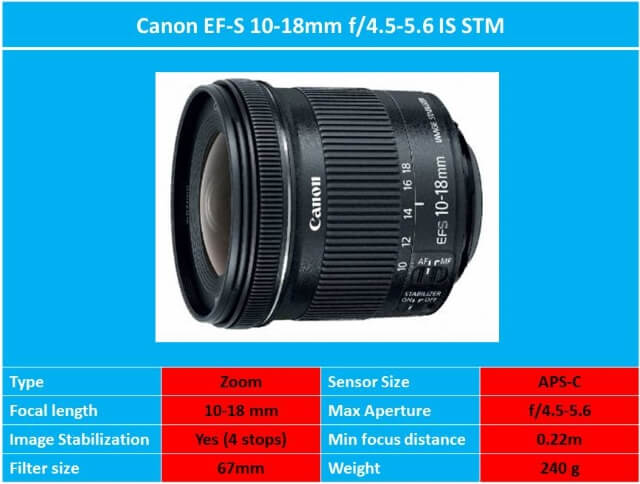
A flexible wide-angle zoom in a compact form factor, the EF-S 10-18mm f/4.5-5.6 IS STM from Canon is a 16-28.8mm equivalent lens designed for EF-S-mount DSLRs. Helping to reduce the overall size while maintaining high optical quality, a four-group zoom design is employed along with one ultra-low dispersion element, one aspherical element, and one large-diameter element to produce sharp, clear imagery void of chromatic and spherical aberrations. A Super Spectra coating has also been applied to suppress flare and ghosting for increased contrast and color neutrality. Benefitting both photo and video applications, an STM stepping AF motor is used to realize quick and near-silent autofocus performance along with full-time manual focus override. Additionally, a four-stop-effective Image Stabilizer system is also featured and minimizes the appearance of camera shake for sharper handheld shooting.
Below is a sample photo by vividmind.uk

Tokina AT-X Pro 11-16mm f/2.8 DX II for Canon

The AT-X 116 PRO DX-II 11-16mm f/2.8 Lens for Canon EF by Tokina is an ultra-wide angle autofocus zoom lens with a fast constant f/2.8 maximum aperture. The AT-X 116 PRO DX-II lens is designed for digital cameras with APS-C-size CMOS or CCD sensors. Its angle of view ranges from 104-84° and it can focus as close as 11.8″. Nine diaphragm blades help to produce soft out-of-focus backgrounds while two Super-Low Dispersion glass elements and two aspheric elements help to achieve excellent contrast, sharpness, and minimal chromatic aberration. As an update to their AT-X 116 PRO DX, Tokina has improved the multi-layer coatings to minimize light reflection and improve optical performance. The PRO DX-II has an internal focusing motor which is ideal if shooting video with your digital camera.
Tokina’s One-Touch Focus Clutch Mechanism allows the photographer to switch between autofocus and manual focus with a simple push of the focus ring. Snapping it forward into autofocus and back into manual focus is all that needs to be done, there’s no need to adjust the AF/MF switch on the camera body.
Below is a sample photo by Gwenaël Piaser

Tokina AT-X Pro 12-28mm f/4 DX for Canon
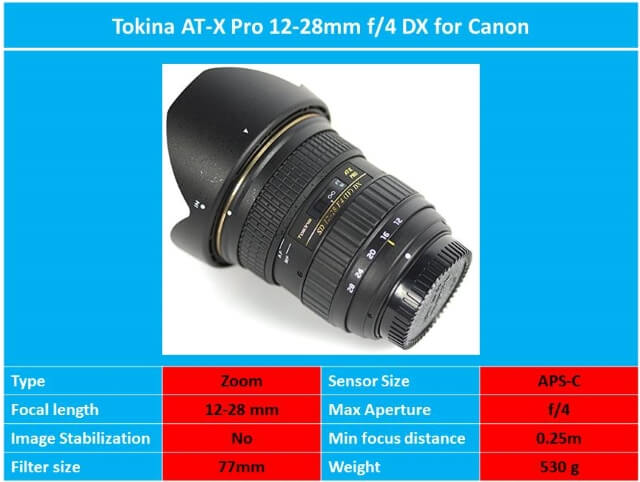
The 12-28mm f/4.0 AT-X Pro APS-C Lens for Canon from Tokina is a wide-angle to a standard length zoom lens with a maximum aperture of f/4.0. It is compatible with Canon APS-C cameras and provides a 35mm focal length equivalency of 19-45mm. This compact lens features a one-touch AF/MF clutch operation to switch back and forth between auto and manual focus, for manual focus slide the focus ring back, and for autofocus allow the ring to rest in the forward position. A newly designed GMR (magnetic precision) AF sensor is mounted close to the AF motor and provides fast, accurate AF. The lens’ SD-M (Silent Drive-Module) means that autofocus responds smoothly and silently, which is ideal when shooting HD video.
The use of SD glass (ultra-low dispersion glass), which emulates fluorite glass in performance, aims to eliminate chromatic aberration and aspherical lens elements in both the front and rear lens groups correct distortion and also helps to minimize aberrations for sharp imaging throughout the zoom range.
Below is a sample photo by kendoman26

Tamron SP AF 10-24mm f/3.5-4.5 DI II for Canon
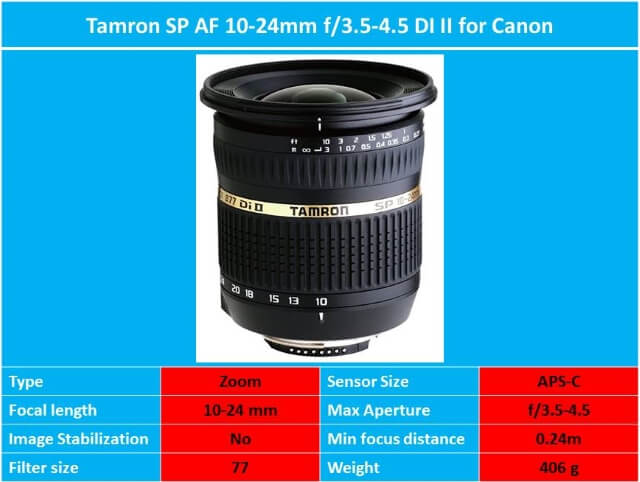
The Tamron SP AF10-24mm f/3.5 -4.5 Di II is an ultra-wide-angle zoom lens. Di II means that it is designed for exclusive use on digital SLR cameras with smaller-size imagers (APS-C/DX). Boasting a focal length range of 10 – 24mm, (the 35mm equivalent of 16mm to 37mm) this lens has a varied range of applications for creating dramatic images as it features both ultra-wide and semi-wide angle settings.
The close focusing capability of this lens enables image capture with an exaggerated perspective at the 10mm ultra-wide-angle end or with a maximum magnification ratio of 1:5 at the 24mm semi-wide-angle. It has Micro Motor to ensure precise and smooth autofocusing.
Below is a sample photo by Pirotek

Canon EF-S 10-22mm f/3.5-4.5 USM
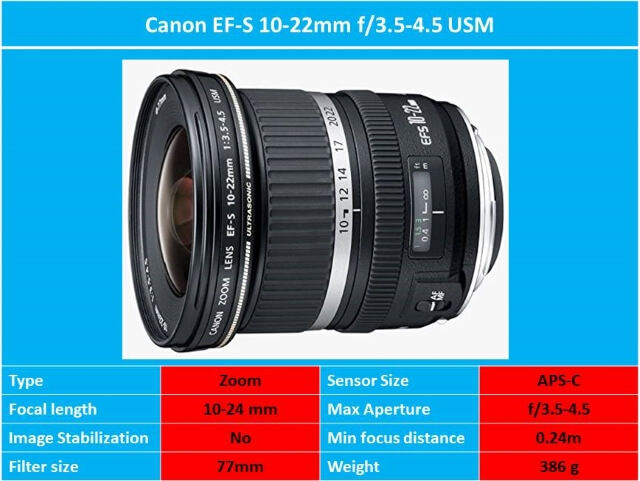
Covering a versatile wide-angle range, the EF-S 10-22mm f/3.5-4.5 USM is designed for Canon EF-S-mount APS-C DSLRs and provides a 16-35.2mm equivalent focal length range to suit working in a wide array of shooting conditions. Benefitting the flexible zoom range is a sophisticated optical design, which includes one Super-UD element and three aspherical elements to control chromatic and spherical aberrations, and a Super Spectra coating has been applied to limit flare and ghosting for improved contrast. Additionally, this lens sports a ring-type USM for quick and quiet autofocus performance and full-time manual focus override, and an internal focus design also quickens focusing speeds and maintains the overall lens length during operation.
The below is a sample photo by michael_d_beckwith


2nd wide angle lenses for Canon full-frame DSLR
Canon EF 11-24mm f/4L USM
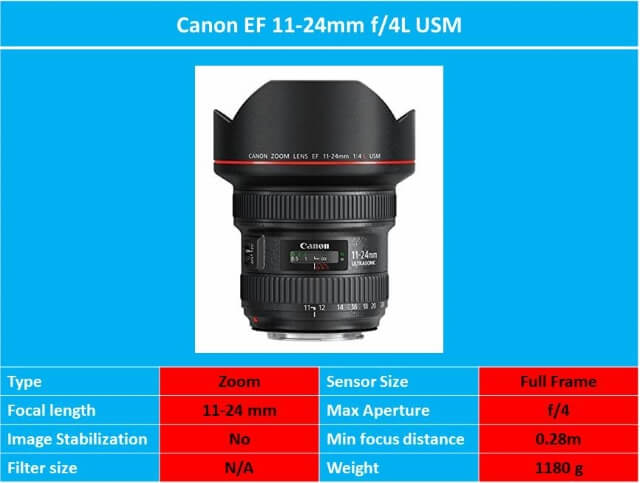
A truly versatile wide-angle zoom featuring advanced optical design and constant f/4 maximum aperture, the Canon EF 11-24mm f/4L USM Lens is a member of the esteemed L-series of lenses designed for full-frame EOS DSLRs. One Super UD element and one UD element offer a significant reduction in chromatic aberrations while four aspherical elements help to minimize distortions throughout the zoom range and provide consistent edge-to-edge sharpness and illumination. Both SWC and ASC coatings have been applied to the elements in order to reduce lens flare and ghosting for increased contrast and color accuracy. Ideally suited for landscape and architectural photography, this lens covers ultra-wide to wide-angle perspectives and backs up its versatile zoom range with sophisticated optical components and intuitive handling.
Regarding focusing performance, a ring-type Ultrasonic Motor offers fast, smooth, and near-silent autofocus, which is further benefitted by full-time manual focus operation and internal focusing design. The lens is both water and dust-resistant, and fluorine coatings have also been applied to the front and rear elements to protect against fingerprints and smudges from affecting image quality.
Below is a sample photo by ansel.ma

Tamron 15-30mm f/2.8 DI VC USD for Canon
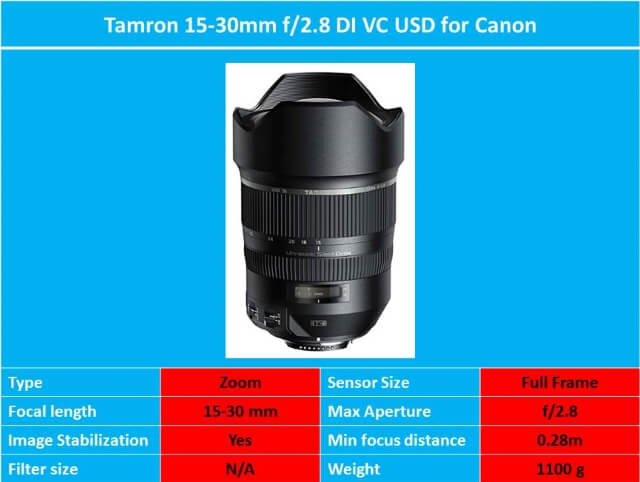
Offering a wide-angle of view for full-frame cameras, the Canon EF mount Tamron SP 15-30mm f/2.8 Di VC USD Lens is a fast wide-angle zoom lens with Vibration Compensation. The f/2.8 maximum aperture performs well in low-light situations and provides a shallow depth of field for selective focus. Further benefitting the lens is the VC (Vibration Compensation) image stabilization, which helps to minimize the appearance of camera shake to enable the use of longer shutter speeds or smaller apertures when hand-holding in low-light conditions. XGM and LD glass elements reduce chromatic aberrations and help ensure sharp and clear imagery. eBAND and BBAR coatings render uniform colors and reduce ghosting and flare, while a fluorine coating on the front element helps repel water or contaminants.
A USD (Ultrasonic Silent Drive) autofocus motor provides quick and precise focusing performance, with high torque, low response times, and quiet operation to benefit both still and video applications. Additionally, a full-time manual focus mechanism enables manual fine-tuning of focus at any point, even when the AF system is engaged.
Below is a sample photo by jonas.wagner

Canon EF 16-35mm f/4L IS USM
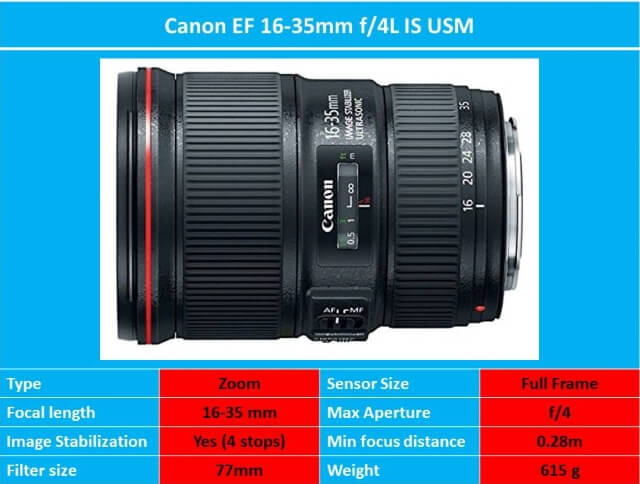
Covering a useful wide-angle focal length range, the EF 16-35mm f/4L IS USM is a Canon L-series lens distinguished by its constant f/4 maximum aperture, sophisticated optical design, and use of image stabilization to realize sharp imagery. Two ultra-low dispersion elements are used to greatly reduce color fringing and chromatic aberrations throughout the zoom range for high clarity and color accuracy, and a Super Spectra coating has also been applied to suppress flare and ghosting for improved contrast. Three aspherical elements are also featured and help to control distortion and minimize spherical aberrations for improved sharpness.
Complementing the imaging capabilities, this wide-angle zoom also features a four-stop-effective Image Stabilizer system that minimizes the appearance of camera shake for sharper handheld shooting. A ring-type USM and internal focusing mechanism also afford quick, quiet, and accurate autofocus performance, as well as full-time manual focus override. Additionally, this lens is weather-sealed and has a protective fluorine coating on the exposed elements for use in trying environmental conditions.
The below is a sample photo by michael_d_beckwith

Canon EF 16-35mm f/2.8L III USM
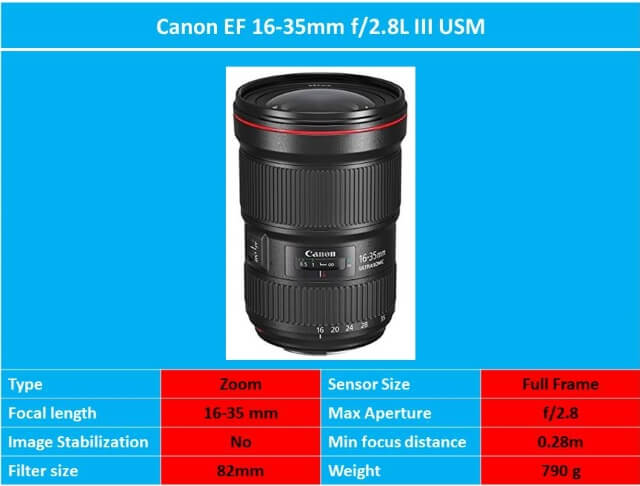
Characterized by a revamped optical design, the EF 16-35mm f/2.8L III USM from Canon is a workhorse wide-angle zoom and member of the well-regarded L-series of lenses. Featuring a series of specialized elements, this lens utilizes a trio of aspherical elements and two ultra-low dispersion glass elements to control a variety of aberrations for high sharpness and clarity. Both SWC and ASC coatings have also been applied to the elements in order to reduce lens flare and ghosting for increased contrast and color accuracy.
Complementing its optical prowess, a ring-type Ultrasonic Motor offers fast, smooth, and near-silent autofocus performance, which is further benefitted by full-time manual focus operation and an internal focusing design. The lens is both water and dust-resistant, and fluorine coatings have also been applied to the front and rear elements to protect against fingerprints and smudges from affecting image quality.
The below is a sample photo by jbkalla

Sigma 12-24mm f/4.5-5.6 DG HSM II for Canon

Sigma’s 12-24mm f/4.5-5.6 DG HSM II Lens (For Canon) is designed for use with full-frame digital cameras and offers a dramatically ultra-wide, minimally distorted zoom lens with a field of view from 122° to 84.1°. This range makes it ideal for the tightest of interiors, as well as for dramatic landscape photography. Using a camera with an APS-C sensor will give you an effective range of 17-35mm, also a very attractive wide-angle zoom range.
One Special Low Dispersion (SLD) glass element and four “F” Low Dispersion (FLD) glass elements compensate for color aberration and deliver improved image quality. Three glass mold elements and one hybrid aspherical lens give you compact, lightweight construction (3.3″ diameter x 4.7″/23.6 oz) and improved performance.
Super Multi-Layer Coating on the lens reduces flare and ghosting, while the Inner Focusing system keeps the length of the lens unchanged when changing focus. The splash-proof design helps protect the 12-24mm lens from the elements. This versatile, sturdy lens will put drama into just about any subject you choose.
Equipped with HSM (Hyper Sonic Motor) for quiet, high-speed focusing, it also offers Full-Time Manual Focusing.
Below is a sample photo by Christopher_Higham

Canon EF 17-40mm f/4L USM
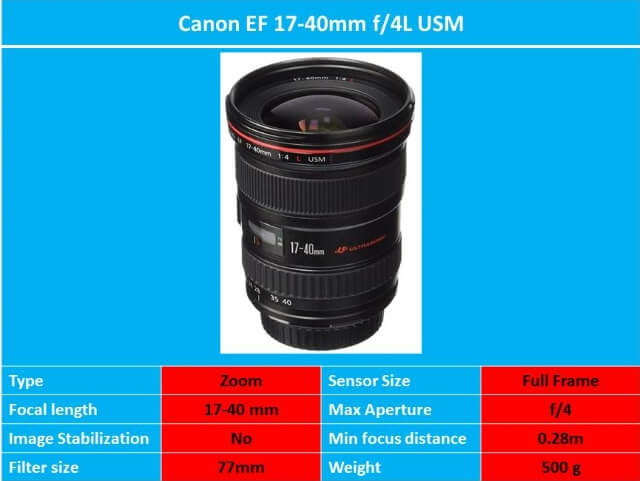
Spanning a versatile wide-angle range, the EF 17-40mm f/4L USM Lens is a Canon L-series zoom featuring a constant f/4 maximum aperture along with a sophisticated optical design and durable construction. One Super UD element is featured, along with three aspherical elements, which help to reduce both chromatic and spherical aberrations in order to realize high sharpness, clarity, and color accuracy. A Super Spectra coating has also been applied to suppress flare and ghosting for improved contrast in difficult lighting conditions. Complementing the imaging capabilities, this wide-angle zoom also features a ring-type USM and internal focusing mechanism to afford quick, quiet, and accurate autofocus performance, as well as full-time manual focus override. Additionally, this lens is weather-sealed for use in trying environmental conditions.
Below is a sample photo by chibitomu

Tokina AT-X 16-28mm f/2.8 PRO FX for Canon
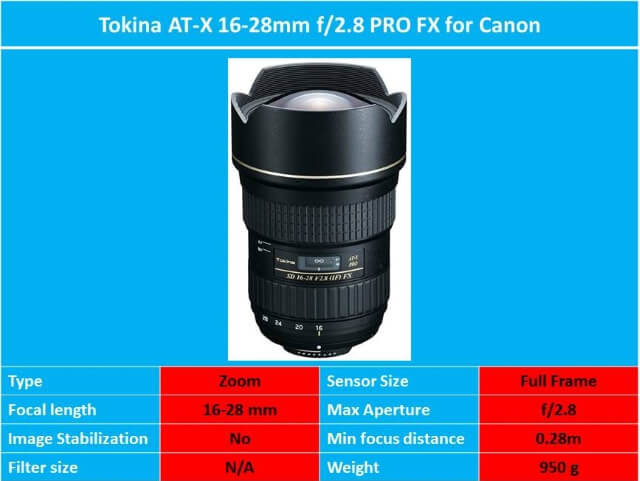
For the professional, a 16-28mm f/2.8 lens is almost a necessity, and this new AT-X 16-28mm f/2.8 Pro FX Lens for Canon from Tokina fills the bill very nicely. Designed specifically for Canon pro-level DSLRs with a full-frame (FX) sensor (such as the Canon EOS 5D Mark II), this super wide-angle zoom has 15 elements in 13 groups, using aspherical and SD super-low dispersion glass elements to reduce chromatic aberration and give maximum resolution. The silent DC motor allows the lens to focus quickly and quietly and works with a GMR magnetic AF sensor to increase AF speed even more. An exclusive One-Touch Focus Clutch mechanism allows switching quickly between autofocus and manual focus by snapping the focus ring forward for AF and back toward the camera for manual focus. And, it’s possible to buy this lens without applying for a mortgage first.
Below is a sample photo by Kartik Ramanathan

Related Posts
Thanks for reading, I hope you enjoyed the article and found what you are looking for. If you have any questions just post them below & I will be happy to answer you.
If you enjoy the site, don’t forget to subscribe, we will only inform you when a new article is posted.









Thanks for this great info. Photography is naturally what I like. I like taking pictures at events and public places. When I was younger even up till now whenever I take pictures I will criticize it by comparing it with other people’s pictures. Later I got to know the reason why sometimes my photo images aren’t bold and sharp. It was because of the poor camera lenses I was using then hence I began to strive for quality resolution camera and lenses.
But recently some powerful phone cameras have been competing with photography business. So what is your opinion about this?
Nice article.
Although there is a fast and great improvement in smartphone cameras I believe they still away from the quality and the power of the DSLR and mirrorless cameras. Thanks for your comment.